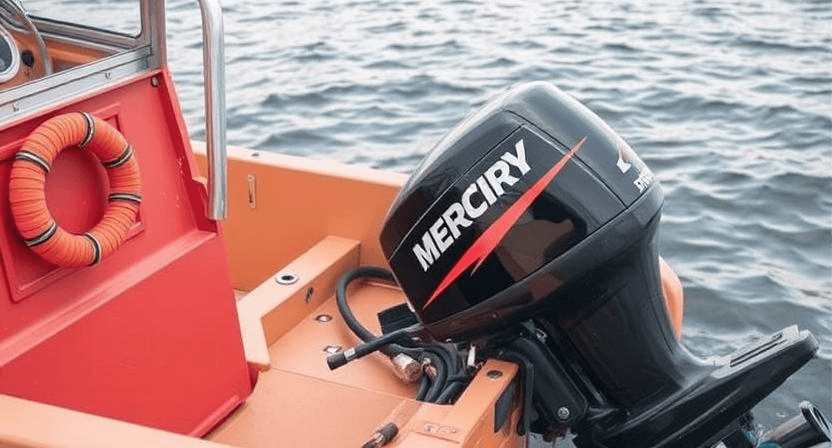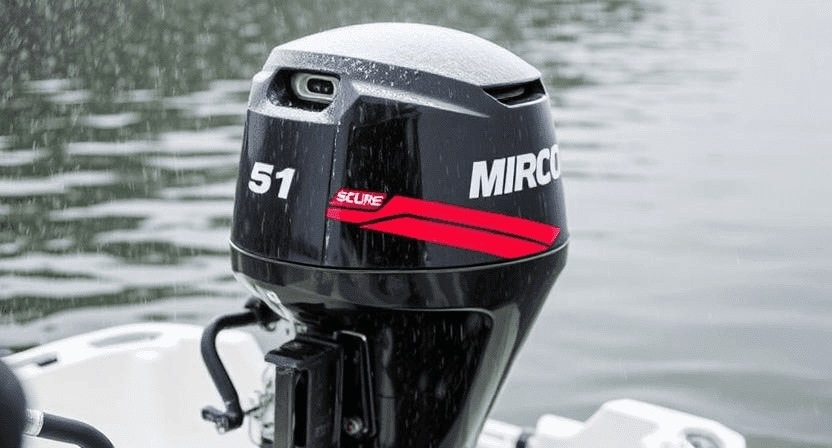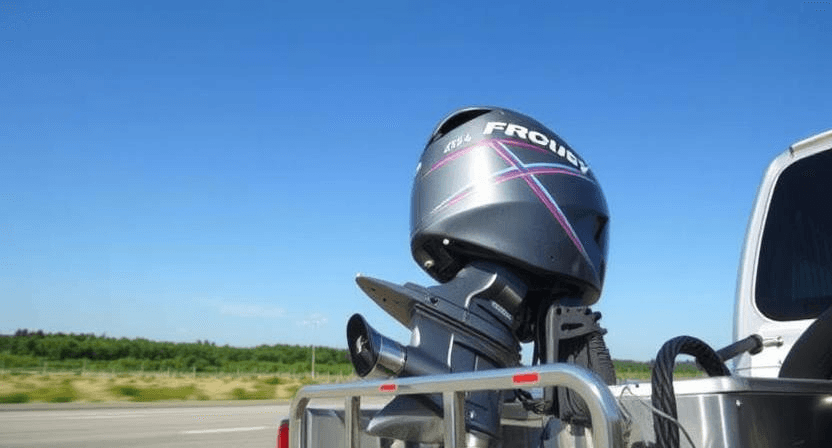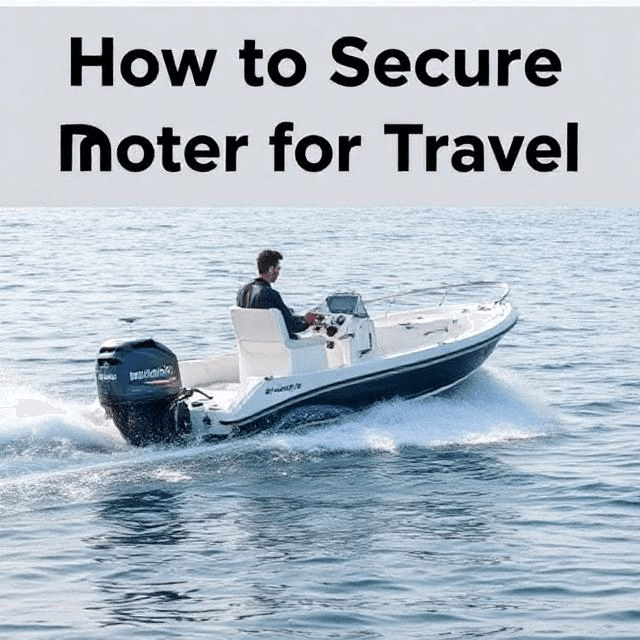Introduction
To safeguard your investment and guarantee a hassle-free trip, it is essential to transport your boat motor properly. Whether you’re traveling across state lines or just to a nearby lake, an unsecured motor can lead to costly damages, road hazards, Secure Boat Motor for Travel or even legal trouble. But don’t worry—this guide will help you master the art of securing your boat motor like a pro.
How to Secure Boat Motor for Travel with expert tips and actionable advice. Discover tools, techniques, and best practices to ensure safe, damage-free transportation.
Understanding the Risks of an Unsecured Boat Motor

An improperly secured boat motor poses significant risks:
- Damage to the Motor: Vibrations and road bumps can lead to wear and tear or even severe structural damage.
- Safety Hazards: Loose motors can fall off, creating dangerous situations for other drivers.
- Legal Trouble: Most states require properly secured loads, and failure to comply can result in fines or penalties.
A boat owner in Florida learned this the hard way when his unsecured motor fell off, causing a multi-car accident and hefty fines. Let’s avoid such scenarios!
Preparation Before Securing the Boat Motor
Preparation is key. Start with these steps:
- Tools and Equipment: Gather tie-down straps, motor support brackets, and a high-quality transom saver.
- Inspection: Ensure your boat and motor are free of damage and operationally sound.
- Choose the Right Trailer: A trailer tailored to your boat size and weight ensures stability. For instance, a tandem-axle trailer provides extra support for larger boats.
Using Motor Support Brackets

Why Motor Support Brackets? They reduce stress on your motor and boat transom during transport.
- Installation Guide:
- Align the bracket with your motor and trailer frame.
- Securely attach it using the provided clamps.
- Effectiveness: A boating enthusiast shared how using a motor support bracket prevented costly repairs after a long trip across California.
Transom Savers: A Must-Have Accessory

How to Secure Boat Motor for Travel:
The transom, which connects your boat to its motor, is particularly vulnerable during transport. A transom saver absorbs road shock, protecting this critical area.
- How to Use:
- Connect one end to the trailer and the other to the motor.
- Tighten securely to minimize movement.
- Case Study: A family in Texas saved their transom from a $2,000 repair bill simply by investing in a $50 transom saver.
The Role of Straps and Tie-Downs

Strong, durable straps are your best friends when securing a boat motor. Opt for ratchet straps or cam buckles for optimal tension.
- Technique: Wrap the straps around the motor, securing it to the trailer frame. Double-check for tightness.
- Common Mistakes: Avoid cheap, low-quality straps or over-tightening, which can damage the motor casing.
Securing the Boat on the Trailer
A properly positioned boat ensures that the motor stays stable throughout the journey. Here’s how you can achieve that:
- Positioning the Boat Correctly: Place the boat so its weight is evenly distributed on the trailer. A misaligned boat can strain the motor and make the trailer unstable.
- Further Tie-Downs: Secure the bow and stern of the boat with additional straps. This minimizes movement during travel, especially on bumpy roads.
- Importance of Wheel Chocks: Prevent the trailer from rolling during loading and unloading by placing chocks behind the wheels.
Weatherproofing Your Secure Boat Motor for Travel

Weather can be unpredictable, so protecting your motor from rain, snow, or dust is a must.
- Motor Covers: Invest in a waterproof, breathable cover that shields against moisture while allowing ventilation to prevent mold.
- Shrink Wraps: For longer trips, shrink-wrapping the motor can provide an extra layer of protection.
- Ventilation Tips: Always ensure there’s enough airflow to prevent condensation inside the wrap or cover.
Tips for Long-Distance Travel with a Boat Motor
If you’re planning a cross-country trip with your boat, these tips will come in handy:
- Check Connections Regularly: At every rest stop, inspect the straps, brackets, and motor for signs of loosening.
- Monitor Tire Pressure: Proper tire pressure reduces trailer swaying, which could stress the motor.
- Real-World Example: A boater who traveled from Colorado to Florida successfully avoided motor damage by following a strict inspection routine at each stop.
Emergency Preparedness
Even with the best precautions, emergencies can happen. Here’s how to stay prepared:
- Travel Kit Essentials: Include extra straps, tools, a first-aid kit, and a flashlight in your kit.
- Responding to Issues: If the motor loosens, safely pull over, assess the situation, and secure it again.
- Roadside Assistance: Always have a roadside assistance number on hand for major issues.
Legal Requirements for Transporting a Boat Motor

Every state in the U.S. has specific regulations about securing loads during travel. Here’s what you need to know Secure Boat Motor for Travel.
- State and Federal Laws: Check the Department of Transportation (DOT) regulations for your state to ensure compliance.
- Required Documentation: Some states may require permits for oversized or heavy loads.
- Avoiding Penalties: A boat owner in New York was fined $500 for an unsecured load; don’t let this be you.
Best Practices for Post-Travel Motor Inspection

Once you’ve arrived at your destination, take time to inspect your boat and motor:
- Check for damage: Look for fractures, dents, or loose pieces.
- Clean the Motor: Remove dirt and debris accumulated during the journey to prevent corrosion.
- Case Study: A boater who ignored post-travel checks discovered extensive rust damage after weeks of storage.
Common Mistakes to Avoid
Many transport mishaps can be avoided by steering clear of these common errors:
- Overlooking Details: Small issues, like loose straps, can escalate during travel.
- Using Outdated Equipment: Worn-out brackets and straps are more likely to fail.
- Ignoring Weight Distribution: An imbalanced load puts undue stress on the trailer and motor.
Benefits of Professional Help
When should the experts be called in? Here’s what to consider:
- When to Hire Professionals: If your boat is exceptionally large or heavy, professional transport services are often the safest option.
- Cost vs. Risk: Weigh the price of professional services against the potential costs of motor damage or accidents.
- Testimonials: A Florida boat owner shared how hiring professionals saved him from damaging his $20,000 motor during a cross-state move.
Final Thought How to Secure Boat Motor for Travel
Secure Boat Motor for Travel doesn’t have to be complicated, but it does require attention to detail. With the right tools, techniques, and preparation, you can transport your motor safely and confidently, whether you’re heading to a nearby lake or across the country. Take the time to protect your investment and avoid the headaches of motor damage or accidents. Remember, safety and preparedness are key!
Get more Detail
What tools do I need to secure my boat motor for travel?
You’ll need motor support brackets, tie-down straps, a transom saver, and possibly a motor cover for weatherproofing.
Are transom savers worth the investment?
Absolutely! They protect the transom from road vibrations, saving you from expensive repairs.
How often should I check my motor during a long trip?
Inspect the motor, straps, and trailer connections at every stop to ensure everything remains secure.
Can I transport my boat motor without a trailer?
It’s not recommended. A trailer provides the necessary stability and support for safe transportation.
What happens if I ignore legal requirements?
You risk fines, penalties, or even liability in case of an accident caused by an unsecured load.



